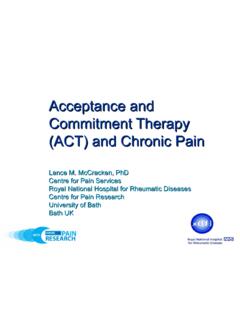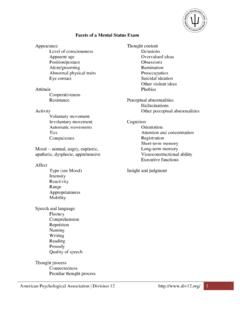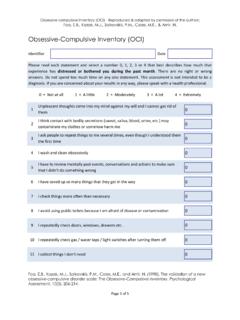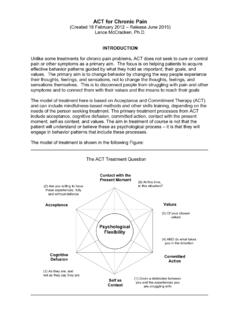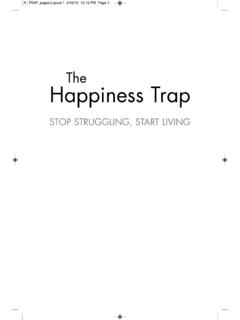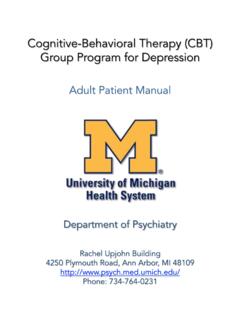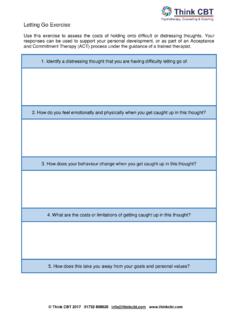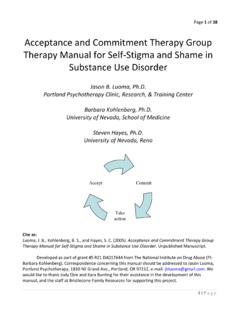Transcription of Life with Chronic Pain: An Acceptance-based Approach ...
1 Life with Chronic Pain: An Acceptance-based Approach Therapist Guide and Patient Workbook Kevin E. Vowles, 1 & John T. Sorrell, 1 Interdisciplinary Musculoskeletal Pain Assessment and Community Treatment Service, The Haywood Hospital & Arthritis UK Primary Care Research Centre, Keele University 2 Pain Management Clinic, Stanford University Vowles & Sorrell, Life with Chronic Pain ii Revision Date: July 2007 Table of Contents Preface and Therapist Notes .. iii Session 1 .. v Session 2 .. vii Session 3 .. xi Session 4 .. xiv Session 5 .. xvi Session 6 .. xix Session 7 .. xxii Session 8 .. xxiv References .. xxv Acknowledgements and Author Contact Information .. xxvii Session 1: Introductions and Basic Foundations of Treatment .. 1 Session 2: Options and Setting a Course for Treatment .. 8 Session 3: Learning to Live with Chronic Pain .. 13 Session 4: Values and Action.
2 20 Session 5: Urges, Thoughts, & Feelings .. 27 Session 6: Action Getting Your Feet Moving .. 32 Session 7: commitment .. 37 Session 8: Lifelong Maintenance .. 39 Vowles & Sorrell, Life with Chronic Pain iii Revision Date: July 2007 Life with Chronic Pain: Preface and Therapist Notes Hello and welcome. We have been working on the present treatment for a number of years now and hope that you find it useful. One of the dilemmas in attempting to derive a treatment protocol is that it often entails formalizing treatment artificially and can convey a certain amount of inflexibility. This is a problem when the theoretical underpinnings of our Approach ( , the third-wave cognitive and behavioral therapies) likely require some degree of flexibility in order to be most effective and achieve the stated goals of therapy . So, while we believe the methods included in the present protocol to be effective and necessary (based on existing corroborative data as well as our own analyses of outcomes), please use it with a degree of healthy skepticism and allow things to flex to best meet the needs of the treatment environment.
3 The treatment itself is designed to take place over eight sessions, each consisting of 90 minutes, although that too is flexible. We have provided a small description of each session, including the session goals, on the following few pages to be used as a rough guide for therapists providing treatment. We would like to add two additional caveats. First, it is assumed that the therapist using this manual is familiar with the assessment and treatment of Chronic pain. Second, it is likely necessary that the therapist also have working knowledge of acceptance and commitment therapy and Relational Frame Theory, and the functional contextualistic philosophy of science and practice underlying them. Therapist competency in both of these areas is likely to effect the fidelity of the treatment provided to the theoretical model from which it was developed, ability of patients to understand treatment material and translate it to their own lives, and, perhaps most importantly, the effectiveness of treatment itself.
4 If you are interested in further training, etc., there are many workshops offered on acceptance and commitment therapy . You may want to take a look at the official website of our organization, the Association for Contextual Behavioral Science (ABCS; ). The website is a fantastic resource for information, articles, treatment protocols, and training opportunities. Access to some parts of the website requires membership. Membership to ABCS is values-based; in other words, you pay what you think it is worth and what you can afford (the minimum is $1). There are listserves for acceptance and commitment therapy and Relational Frame Theory (see the website for details). We have found the listserves to be a great place to ask questions and discuss issues in a supportive and stimulating environment. Finally, we have provided an abbreviated list of readings and references, which may be of use. In particular, there are now two useful books on the subject of acceptance and Chronic pain (Dahl et al.)
5 , 2005; McCracken, 2005). Vowles & Sorrell, Life with Chronic Pain iv Revision Date: July 2007 The present manual is in its third iteration. We began work on it in 2004 while in the final years of our doctoral training (post-doctoral fellowship for JTS and pre-doctoral internship for KEV). Over the years, we have refined our methods and techniques based on clinical observations, outcome data, continued advancement of the field, and feedback from patients. It is not copyrighted, so feel free to copy and distribute it to patients or providers as necessary. We do ask, however, that our names remain attached to the document. As of 2008, both this manual and its corresponding treatment program are still under development and refinement. Please contact either of the authors to offer feedback, suggestions, or to determine the latest revisions or treatment effectiveness information. **A brief note regarding metaphors and experiential exercises: Using a contextual Approach often entails the use of metaphor and moment to moment experiences as one way of circumventing some of the naturally occurring (and at times problematic) characteristics of language and thinking in humans, particularly as they relate to verbal rules.
6 We have observed that those who are new to this Approach ( , us when we were putting the first draft of this manual together!) will sometimes overuse metaphors in treatment or will inform their patients of the meaning of the metaphor before using it in treatment, which likely undermines its value and impact. As responsible and caring clinicians, we want to do everything possible to ensure that our patients get all they can out of treatment, but there may be a need to step back and let patients get out of it what they will get out of it in other words, we may need to take a leap of faith (off a chair perhaps?) that the people who we treat will get it and resist our own urges to guide them too much. They may not always get it in the way we want them too the space between is likely fertile ground for the work of treatment. Update: September 2008 We are about to post this manual to the ABCS website, which means it effectively leaves our hands a good thing.
7 At the very least, a small update is required as a complete update of this manual is not feasible at present. In the time that have passed since our last revision, there has been substantial work in this area. A few key references that may be of interest follow (see complete references on p. xxv). First, an excellent self-help book has been published by JoAnne Dahl & Tobias Lundgren (2006). Second, our early pilot work using this manual is in press at Cognitive and Behavioral Practice and a draft version of the manuscript is available on the ABCS website ( ). Finally, there are at least ten trials of ACT in Chronic pain that are published or in press this is certainly an active area. You can search for recent trials listed on PubMed by clicking: +pain+ acceptance +outcome Again, thanks for your interest and hope this work is of some use. Vowles & Sorrell, Life with Chronic Pain v Revision Date: July 2007 Revision Date: July 2007 Session 1: Introduction and the Treatment Agenda 1) Providing the opportunity for patients to become familiar with each other and the treatment aims.
8 Initially, we allow each group participant to tell his or her story . Issues often discussed include history of pain and specific areas in which difficulties and suffering are occurring. We generally focus on functional issues early in treatment by asking participants what brought them to treatment and what they expect to get out of participating in it. This discussion provides an occasion to gently begin to shape the treatment focus and participant expectations. Finally, it is usually a nice opportunity for some normalization of individual experiences to begin. 2) Determine the change agenda through the use of a creative hopelessness exercise (see Hayes et al., 1999, as well as Dahl et al., 2005 & McCracken, 2005). We then ask each individual to state how long pain has been occurring and we then calculate a rough average (or any other measure of central tendency). This allows the therapist to acknowledge the longstanding nature of pain, as well as comment on the importance of the patients experience in their role of living with ongoing pain, as they are the true pain experts.
9 Next, participants are asked to list all previous treatments for pain. Lance McCracken, in his 2005 book, also mentions that they have used this exercise to discuss other behaviors that have been used in the past to cope with pain ( , avoiding social situations, use of canes/wheelchairs, activity limitations/resting). Generally speaking, we have found that even a small group of patients will provide a list of almost every available treatment, conventional and otherwise. We have found it useful to also ask participants about other things they have tried to minimize the impact of pain on their lives ( , turn down social invitations, stop working/playing sports/etc.). The therapist can also use this time to provide some general education on previous pain treatment strategies and the data, or lack thereof sometimes, which underlies them. Finally, we run through an analysis of prior treatments and divide these up into short and long-term consequences.
10 It usually becomes quite apparent that previous treatments have had few, if any, long-term benefits, and have significant costs, over both the short and long term. We try to avoid using this as an opportunity to bash previous treatments and instead use it to fuel some discussion on what has been learned and what potential options exist. Dahl et al. (2004) have used a similar exercise and use the opportunity to ask, What does your experience tell you? which may afford the same opportunities to begin the process of shifting the treatment agenda from one of pain control to one more functional in orientation. Vowles & Sorrell, Life with Chronic Pain vi Revision Date: July 2007 It is quite common for this exercise to have significant emotional impact on patients, as they come in contact with the possibility that the pursuit of pain control has resulted in few beneficial outcomes, while it may have contributed to suffering.
